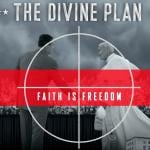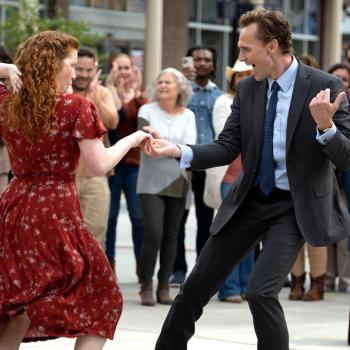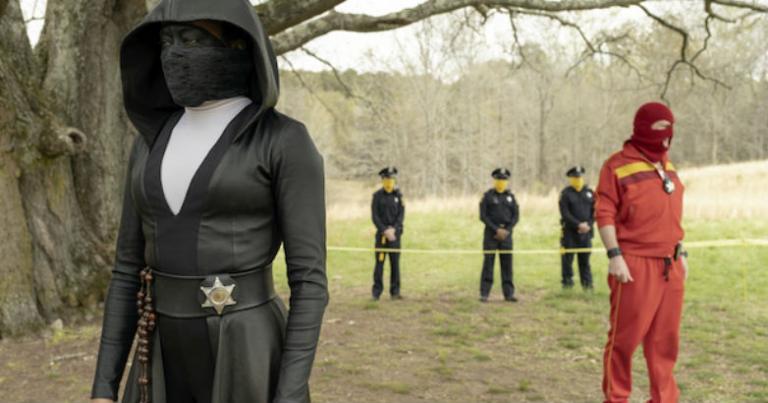
I need to say a couple things up front. First, I’m not a huge comics person, and when I am, it’s Marvel. So this is not going to be a dissection of Watchmen and What It All Means. Second, as to what’s up with Sister Night and that rosary — I don’t know. But when we get the answer, I hope it’s good.
(MINIMAL AND VAGUE SPOILERS, but if you want to remain pure as the driven snow regarding this show, leave now.)
Having premiered on Oct. 20 on HBO and airing Sundays at 9 p.m. ET/PT, Watchmen (official site here) is a sequel to the comic-book limited series of the same name, created in the 1980s by Brits Alan Moore (writer), Dave Gibbons (artist) and John Higgins (colorist), and published by DC Comics.
In extremely brief, it’s an alternate-universe story (DC apparently loves these), where superheroes appeared in the ’40s and ’60s and changed history. In the mid-’80s, the country is teetering on the edge of nuclear war with the Soviet Union — until an evil mastermind drops a giant squid on New York City.
Little did Moore know then that, through the efforts of U.S. President Ronald Reagan, U.K. Prime Minister Margaret Thatcher, Saint Pope John Paul II and many other less-famous people, the Soviet Union collapsed of its own weight by the end of the decade. Our problems are far from over, but that particular chapter did close without mutually assured nuclear destruction — no squid necessary.
But, hey, Robert Redford is president!
Watchmen continues the story in an alternate version of 2019 Tulsa, Oklahoma, with a convoluted plot involving white supremacists attacking police, conspiracies, outer space, much butt-kicking and peculiar atmospheric phenomena involving the aforementioned cephalopods.
Anyway, to read about Watchmen from the perspective of someone familiar with the comics, click here for this story by my Family Theater Productions colleague Father Vince Kuna, a USC film-school grad and certified comics nerd. Also, click here for another of many stories about the show (critics are Watchmen fans, apparently) that gives a fairly comprehensive rundown.
What piqued my curiosity is the main character (created for the series), Tulsa undercover cop Angela Abar (Regina King), works in a costumed, masked persona she calls Sister Night (the whole Tulsa PD wears masks, including a giant panda head, for their personal safety. Yeah. Anyway …)
As Sister Night, Abar wears a pull-up mask, a long, hooded black leather coat, black leggings and boots, and a white turtleneck. A police star is attached to her wide belt, and a long rosary with big wooden beads is also looped around it. In the pilot, she pulls off the rosary and apparently beats someone with it.
After the pilot screening, I went to a party where copies of the costume were on display. Curious, I decided to take some close-up pictures of the rosary.
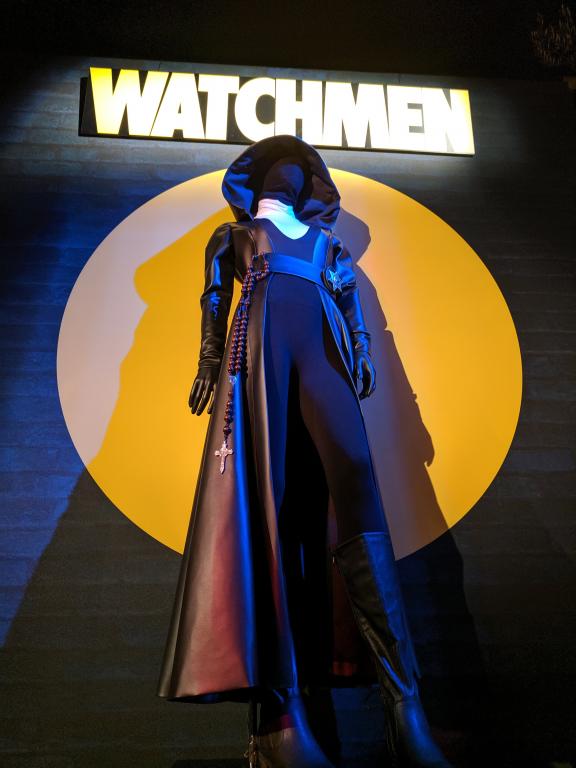
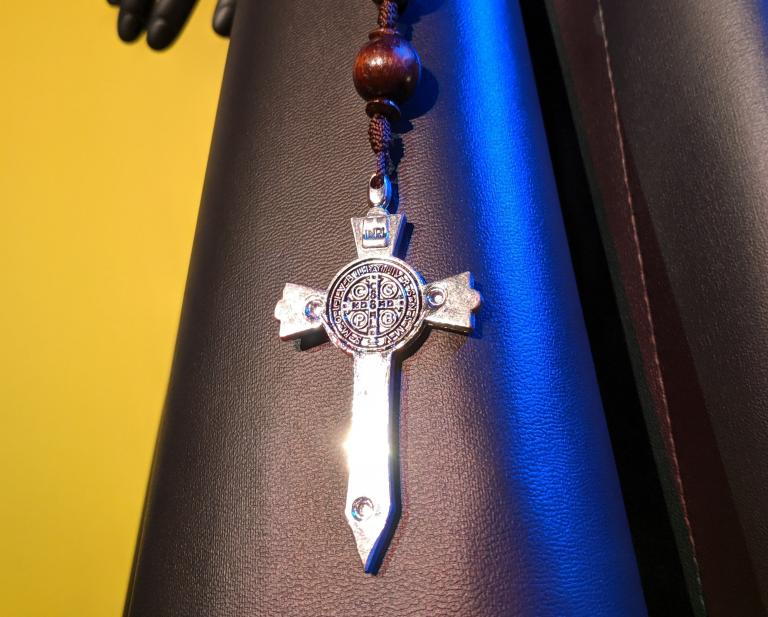
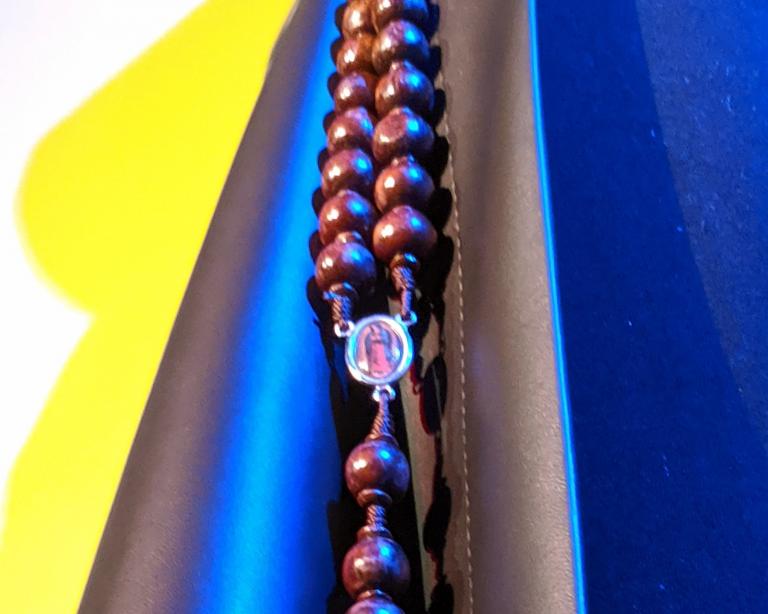
As you can see, the crucifix, while it doesn’t have Christ on it, does appear to have something like a St. Benedict medal, and the connector has an image of Our Lady of Guadalupe.
I’ve seen six episodes of the show, and an explanation for the Sister Night persona has yet to emerge. One character asks Angela directly why she dresses like a nun and doesn’t get an answer. In another scene, Angela’s husband tells a child that heaven is “pretend,” so it doesn’t appear that he, at least, is even Christian.
I checked with the folks at HBO and was told that the answer would be provided in a future episode — which, considering it’s a nine-episode season, means in episode seven, eight or nine. But, Watchmen is created by Damon Lindelof of ABC’s Lost, which had inadequate or no explanations for smoke monsters, four-toed humanoid statues or polar bears on a tropical island. Suffice to say, my expectations aren’t high.
As for the series itself, after six episodes, I’m not too sure what it’s about or what it’s trying to say, other than that all white men in Oklahoma are likely racists.
The show does open with a real-life event, the Tulsa Race Riot (a k a Tulsa Massacre) of 1921 (more on that here), in which a series of events led to a violent assault by white attackers on the affluent African-American neighborhood of Greenwood, called the “Black Wall Street.” It’s estimated that between 100 and 300 people were killed.
By throwing a spotlight on this sadly overlooked but significant tragedy, Watchmen has done a service. I can only hope that being the inciting incident for a comic-book series isn’t the only time this event is given screen treatment.
Oh, and the white supremacists shoot a video in what looks like a Catholic church (or, as one character opines, “It could be Episcopalian.”). All I can say is, don’t concern yourself about that.
I’m not uniformly averse to alternate-reality stories, but they have hazards of their own. When real history is lumped in with invented history, it’s helpful for people to have a place to put their feet, a point where the story clearly diverges from the history we know into a different timeline. By stretching back before the time period of the original Watchmen comics into the 1920s, even with as many episodes as I’ve seen, I’m not sure where that solid ground exists.
The 2019 Tulsa of Watchmen has sophisticated electronics but no cellphones. The cars are a mishmash of styles and times (Angela’s cop car looks a great deal like the black sedan from Men in Black). There are things we recognize, like the musical Oklahoma, and things we don’t, like rains of tiny squids and flying police vehicles.
Everything in the world exists in a context (including technology and race relations, for example), and when you start throwing things into a Scrabble cup and mix them up, it can make a story difficult to comprehend.
That’s why J.R.R. Tolkien was so obsessive in his world-building for The Lord of the Rings, so that, in the fictional realm of Middle Earth, you’d understand what belonged and what didn’t, what was important and what wasn’t, and how groups of people related to each other and to the world around them. It’s a tricky business. Here, even an obsessive knowledge of the Watchmen comics won’t solve the problem, since much of the series is original material.
It may be that Watchmen, like Lost before it, requires a continual suspension of disbelief and a willingness to just float along in hopes that, by the end, it all makes sense.
But, as I said, my expectations aren’t high.
https://youtu.be/-33JCGEGzwU
P.S. Jeremy Irons appears in Watchmen as an enigmatic character, first seen riding in on a beautiful white horse. That reminded me of when I interviewed Irons for Showtime’s The Borgias in 2011 (click here for that). I was sitting in the courtyard of the Langham Huntington Hotel in Pasadena, California, waiting for Irons, when he strode in, wearing laced-up riding boots, with saddlebags slung over his shoulder. I asked him if he had any trouble with his horse at the valet, and he replied that he’d just gotten off a plane.
So, we went on with the interview.
Images: HBO; Kate O’Hare
Don’t miss a thing: Subscribe to all that I write at Authory.com/KateOHare
And, head over to my other home, as Social Media Manager at Family Theater Productions; and check out FTP’s Faith & Family Media Blog, and our YouTube Channel.




